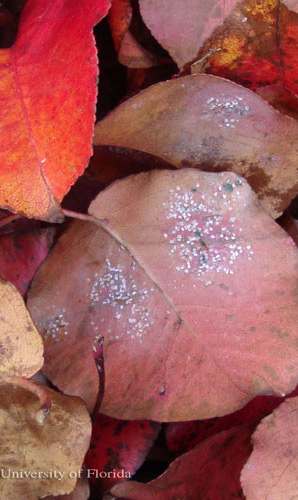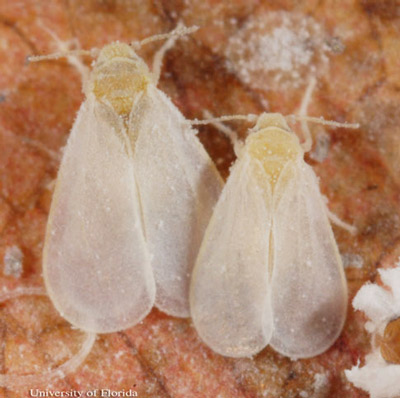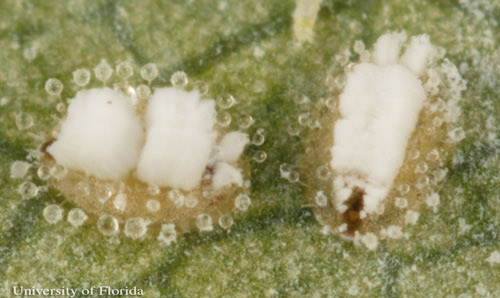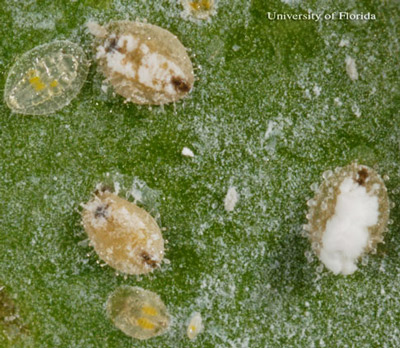common name: ash whitefly
scientific name: Siphoninus phillyreae (Haliday) (Insecta: Hemiptera: Aleyrodidae:
Aleyrodinae)
Introduction - Synonymy - Distribution - Description and Biology - Host Plants - Natural Enemies - Selected References
Introduction (Back to Top)
The ash whitefly, Siphoninus phillyreae (Haliday), is a pest of numerous ornamental and fruit crops, including citrus. It causes severe damage to pear and apple in Europe. Most ash whiteflies in California were found on pomegranate, ash tree, pear, apple, loquat and citrus. Heavy infestations cause leaf wilt, early leaf drop and smaller fruit (Bellows et al. 1990).
Discovered in Florida in 2010, if it becomes established it could become a pest of ornamental plants and possibly other crops.
Figure 1. Several life stages of the ash whitefly, Siphoninus phillyreae (Haliday), on fallen Bradford pear leaves. Photograph by Lyle J. Buss, University of Florida.
Synonymy (Back to Top)
The ash whitefly, Siphoninus phillyreae, was described as Aleyrodes phillyreae by Haliday (1835), on Phillyrea latifolia collected in Dublin, Ireland. It has several synonyms listed in Mound and Halsey (1978).
Distribution (Back to Top)
Native to Europe, the Mediterranean and northern Africa, the ash whitefly is found in numerous countries, including:
Africa: Cameroon, Egypt, Ethiopia, Libya, Morocco, Sudan
Asia: India, Iran, Israel, Pakistan, Saudi Arabia, Syria
Europe: Austria, Corsica, Czech Republic, Cyprus, England, France, Germany, Hungary, Ireland, Italy, Poland, Romania, Spain, Switzerland, Yugoslavia
North America: United States (California, Florida)
Oceania: Australia (New South Wales, South Australia, Queensland and Victoria)
(Mound and Halsey 1978, Bellows et al. 1990, Raymond Gill personal communication, Chris Baptista personal communication, Stocks and Hodges 2010).
In the United States, ash whitefly was first collected in Los Angeles County, California in 1988, and then spread to other counties. It was later discovered in Arizona, Nevada and New Mexico. It appeared in Raleigh, North Carolina in 1993. It is also reported from Arizona, Georgia, Nevada, New Mexico, South Carolina and Texas. A successful biological control program using a parasitic wasp reduced infestations to undetectable levels (western states) or possibly eliminated the infestion (North Carolina). In 2010, it was discovered in central (Lake Buena Vista) and northwestern (Panama City) Florida (Stocks and Hodges 2010).
Description and Biology (Back to Top)
Adult: The adult appears much like a typical whitefly with a light dusting of white wax. Depending on temperature, females live from 30 to 60 days, while males live an average of nine days. This rapid development time, without the presence of the parasitiod, initially produced numerous generations per year in California, whereas only two to three generations were reported in Egypt. Plus, the ability of all life stages to overwinter on non-deciduous hosts allows a rapid build-up in population at the start of the season (Stocks and Hodges 2010). Winged females lays eggs on the underside of the leaves. When the nymphs emerge, they rarely move far and feed on the plant sap until pupation (Gillespie 2000).
Figure 2. Adult ash whiteflies, Siphoninus phillyreae (Haliday). Photograph by Lyle J. Buss, University of Florida.
Pupa: On first observation, the pupal case appears similar to the white armor of a male snow scale. Closer observation with a hand lens reveals a whitefly pupal case with two longitudinal tufts of white wax. The vasiform orifice is surrounded by dark brown derma (inner, thicker layer of the cuticle), with the anal area appearing as a dark brown spot. Lateral areas of the pupal case are light beige. Depending on the age, lesser or greater amounts of white wax will be present. The dorsal surface has 40 to 50 long glassy tubercles similar to the cornicles found on aphids. These tubercular structures produce a droplet of glassy wax and this gives the pupal case an unusual appearance. The longitudinal white tufts of wax obscure some glassy tubercles (R.J. Gill, personal communication). The pupal case size is 0.8 to 1.0 mm long by 0.55 to 0.7 mm wide and is tan or beige in color(Mound 1966, Stocks and Hodges 2010).
Figure 3. Pupal stage of the ash whitefly, Siphoninus phillyreae (Haliday), showing glassy, wax droplets. Photograph by Lyle J. Buss, University of Florida.
Figure 4. Puparia (3 tan-colored individuals) and juveniles (translucent nymphs) of the ash whitefly, Siphonius phillyreae (Haliday), on pomegranate. Photograph by Lyle J. Buss, University of Florida.
Host Plants (Back to Top)
The ash whitefly is a polyphagous species found on several plant families, (modified from Bellows et al. 1990) including:
Bignoniaceae:
Catalpa X chilopsis, catalpa hybrid
Leguminosae:
Afzelia sp., pod mahogany
Cercis occidentalis, western redbud; Cercis siliquastrum, Judas tree
Lythraceae:
Lagerstroemia indica, crape myrtle
Magnoliaceae:
Liriodendron tulipifera, tulip tree
Magnolia stellata, star magnolia
Oleaceae:
Fraxinus excelsior, European ash; Fraxinus latifolia, Oregon ash; Fraxinus ornus, flowering ash; Fraxinus syriaca, Syrian ash; Fraxinus uhdei, Shamel ash; Fraxinus uhdei 'Tomlinson', Tomlinson ash; Fraxinus velutina 'Modesto', Modesto ash; Fraxinus velutina var. glabra, Arizona ash; Fraxinus velutina var. coriacea, western ash
Ligustrum spp., privets
Olea africana (=Olea chrysophylla), wild olive; Olea europaea, common olive
Phillyrea latifolia (=Phillyrea media), a phillyrea
Syringa X hyacinthiflora, a common lilac; Syringa laciniata, cut-leaf lilac; Syringa vulgaris, common lilac
Punicaceae:
Punica granatum, pomegranate
Rhamnaceae:
Rhamnus alaternus, buckthorn
Ziziphus spina-christi, crown of thorns
Rosaceae:
Amelanchier denticulata, serviceberry
Chaenomeles X speciosa, flowering quince
Crataegus mollis, hawthorn; Crataegus monogyna, English hawthorn; Crataegus laevigata (=Crataegus oxyacantha), hawthorn
Cydonia oblonga, quince
Eriobotrya deflexa, golden loquat
Heteromeles arbutifolia, California Christmas berry
Malus domestica, apple; Malus floribunda, Japanese flowering crab; Malus fusca, Oregon crabapple; Malus 'Hopa', a crabapple; Malus 'Red Jade', a crabapple;Malus X scheideckeri, Scheidecker crabapple
Mespilus sp., mespilus
Prunus armeniaca, apricot; Prunus X blireiana, blue plum hybrid; Prunus persica, peach; Prunus salicina, Santa Rosa plum; Prunus virginiana var. melanocarpa, choke cherry
Pyracantha sp., pyracantha
Pyrus calleryana, ornamental pear; Pyrus communis (=Pyrus sativa), pear; Pyrus kawakamii, flowering pear; Pyrus pyrifolia, Japanese sand pear
Rubiaceae:
Cephalanthus occidentalis var. californicus, buttonbush
Rutaceae:
Citrus sp., tangerine; Citrus limon, lemon; Citrus sinensis, navel orange; Citrus sinensis, Valencia orange
Fortunella sp., kumquat.
Natural Enemies (Back to Top)
Ash whitefly has the potential to become a serious pest in new environments. However, it has several natural enemies that can control its populations to under economic thresholds. These natural enemies include (Stocks and Hodges 2010):
Predators:
Clitostethus arcuatus (Rossi)
Menochilus sexmaculatus (Fabricius)
Scymnus pallidivestis Mulsant
Parasites:
Coccophagus eleaphilus Silvestri
Encarsia inaron (Walker), Encarsia partenopea Masi, Encarsia formosa Gahan, Encarsia galilea Rivnay, Encarsia punicae Hayat, Encarsia pseudopartenopea Viggiani and Mazzone, Encarsia siphonini Silvestri
Eretmocerus corni Haldeman, Eretmocerus siphonini Viggiani and Battaglia
The California Department of Food and Agriculture imported Encarsia sp. from Israel and Italy, and the coccinellid beetle Clitostethus arcuatus for the control of ash whitefly in California (Bellows et al. 1990). Encarsia inaron was discovered in the ash whitefly infestation in central Florida, while an unidentified parasitoid was associated with the infestation in northwestern Florida.
Selected References (Back to Top)
- Bellows TS, Paine TD, Arakawa KY, Meisenbacher C, Leddy P, Kabashimo J. 1990. Biological control sought for ash whitefly. California Agriculture 44: 4-6.
- Evans GA, Hamon AB. (5 November 2002). Whitefly taxonomic and ecological Web site: an on-line interactive catalog of the whiteflies (Hemiptera: Aleyrodidae) of the world and their parasites and predators. http://www.fsca-dpi.org/homoptera_hemiptera/Whitefly/whitefly_catalog.htm (6 May 2020).
- Haliday AH. 1835. Aleyrodes phillyreae. Entomology Magazine 2: 119-120.
- Huffman D, Kidd KA. (January 2010). Ash whitefly in North Carolina. North Carolina State University Insect Notes. https://content.ces.ncsu.edu/ash-whitefly (6 May 2020).
- Mound LA. 1966. A revision of the British Aleyrodidae (Hemiptera: Homoptera). Bulletin of the British Museum of National History, Entomolgy 17: 419-420.
- Mound LA, Halsey SH. 1978. Whitefly of the World. A Systematic Catalogue of the Aleyrodidae (Homoptera) with Host Plant and Natural Enemy Data. British Museum of Natural History) and John Wiley and Sons, New York, NY. pp. 192-193.
- Paine T, Bellows T, Hoddle M. (May 2009). Ash whitefly. Center for Invasive Species Research. http://cisr.ucr.edu/ash_whitefly.html (6 May 2020).
- Pickett CH, Pitcairn MJ. 1999. Classical biological control of ash whitefly: factors contributing to its success in California. Biocontrol 44: 143-158.
- Stocks I, Hodges G. (September 2010). Ash whitefly, Siphoninus phillyreae (Haliday), a new exotic whitefly (Hemiptera: Aleyrodidae) in central Florida, and Encarsia inaron, its parasitoid (Hymenoptera: Aphelinidae). Division of Plant Industry. http://http://www.freshfromflorida.com/pi/pest_alerts/pdf/ash-whitefly-pest-alert.pdf (20 September 2010).
- Viggiani G, Mazzone P. 1980. Encarsia pseudopartenopea n.sp., parassita di Siphoninus phillyreae (Haliday) (Hom. Aleyrodidae). Bollettino el Laboratorio di Entomologia Agraria 'Filippo Silvestri' 37: 9-12.
- Viggiani G, Battaglia D. 1983. Le specie italiane del genere Eretmocerus Hald. (Hymenoptera: Aphelinidae). Bolletino del Laboratorio di Entomologia Agraria 'Filippo Silvestri' 40: 97-101.



